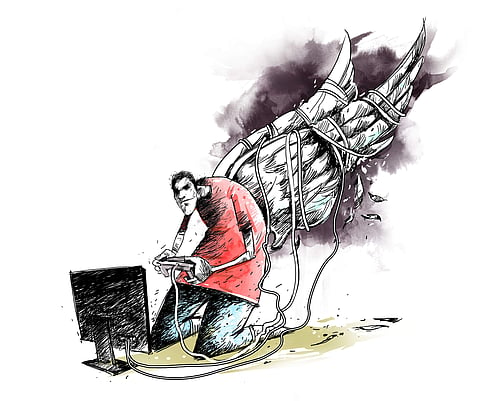

Have you ever considered spending your entire pocket money/salary on video games? You might have at least thought about it. The avid gamer in me sure has! But did you actually go through with it more than once? If you have, then you might be suffering from gaming addiction, one of the most common addictions in young adults aged between 16 and 20.
In one such case, from the archives of NIMHANS’ case studies, a 17-year-old, who was among the top three students until class VIII, started spending 10–14 hours a day playing games. He not only started skipping classes, but also failed to clear his exams. He preferred to take all his meals at his computer table. His behaviour turned rough by the day and he even went to the extent of hitting his mother. His mother's plea, the excessive neck pain, fatigue and the eye strain all together were not enough to push him to quit the game box.
That's when NIMHANS’ Services for Healthy Use of Technology (SHUT) was considered by the boy’s parents, and clinical psychologist Dr Manoj Sharma, who also heads the department, came to their rescue. For Dr Manoj, this case wasn't out of the ordinary. He had seen many cases of youngsters spending their entire salary on gaming and not speaking to anyone for the whole day as they would be glued to their game box.
But just because we live in the age of technology, does it mean that it isn't a problem? The problem is very real — the National Center for Biotechnology Information has placed it alongside the main disorders. The information centre also suggests that there should be certain legal limitations on sale, purchase and access to online games. While gaming is the most prominent addiction of all the technologies available to kids nowadays, it is loosely followed by social media, YouTube, selfies, ebooks and porn.
To treat these addictions is not the easiest thing to do and according to Dr Manoj, it requires a truckload of patience for the science to work. "In most of the cases, the treatment is being initiated by parents following the erratic behaviour of their kids. As far as cooperation from the kids is concerned, it remains a variable as stress can cause fluctuation in their motivation, which in turn makes them less interested in the treatment," he says.
The process, once started, is cumbersome. It begins with a clinical interview to quantify the use of technology by the subject. The second stage involves motivating the kids to bring the necessary changes in their lifestyle, like their sleep pattern, food intake and communication. "We also encourage the subjects to do home assignments, which will help them spend some time away from their respective addiction," explains Dr Manoj.
If we go by the numbers, the problem doesn't seem to subside. "When we started the clinic in 2014, we used to get less than two cases a week. The number has now risen to a minimum of eight cases a week, " informs Dr Manoj. But the department is not ready to give up either. "The aims is to help anyone who is suffering from addiction. That was why SHUT was formed," concludes Dr Manoj, stating that selfies and social media addiction are next on the list.
